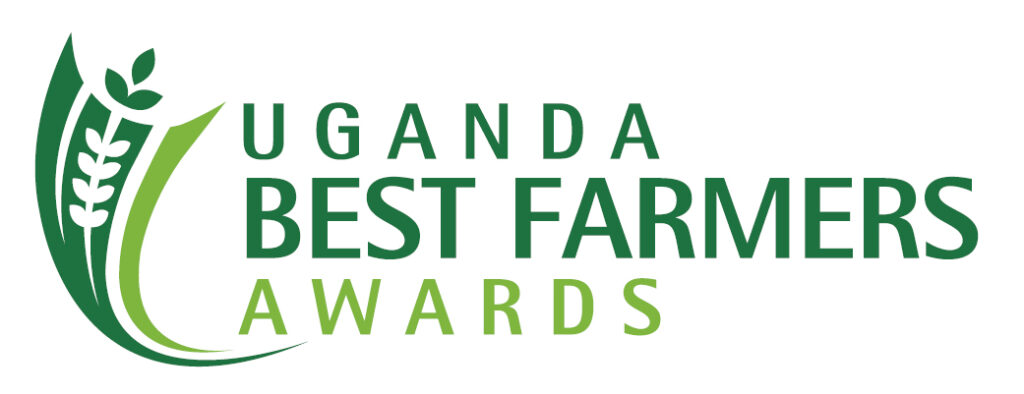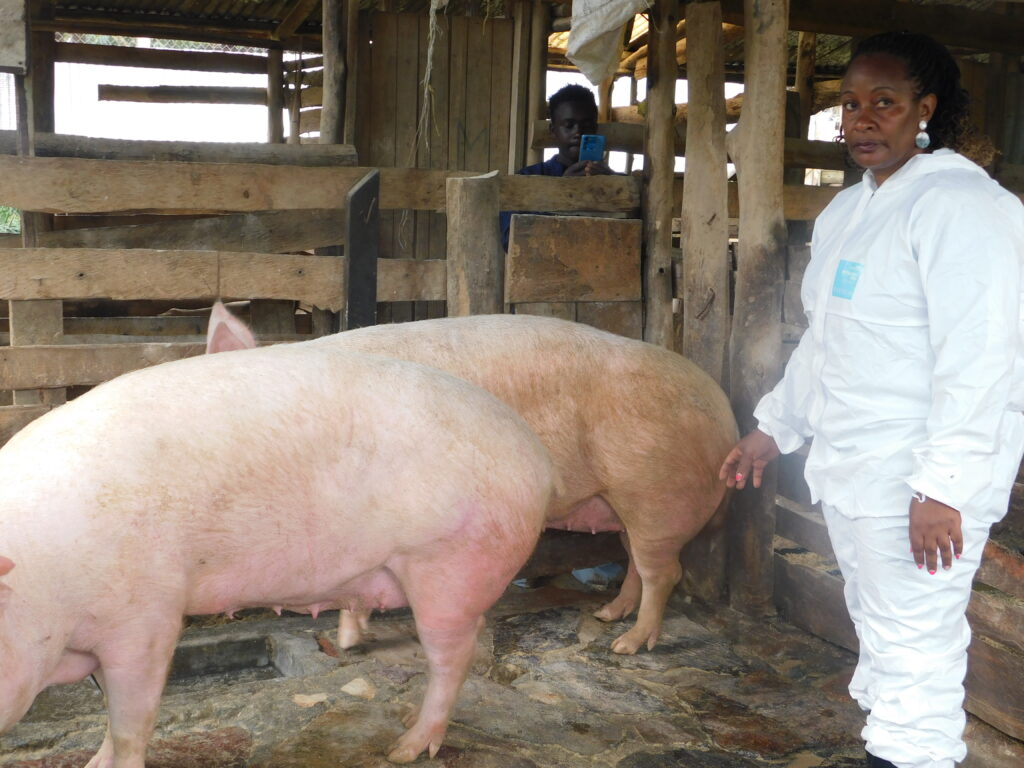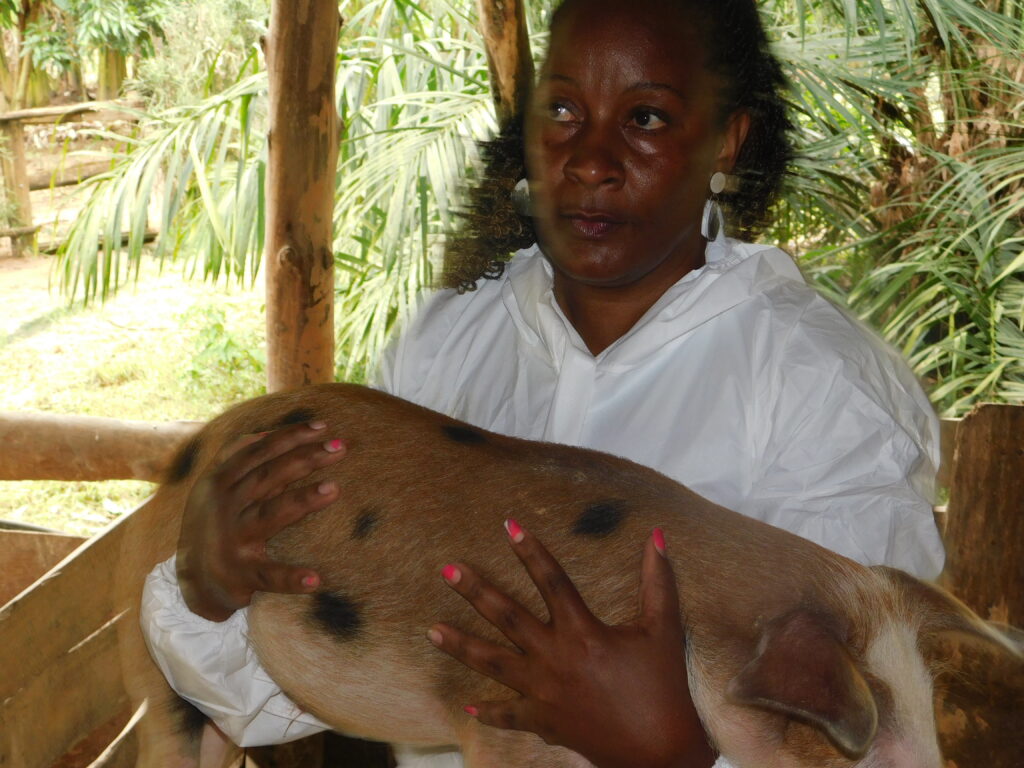
By Joshua Kato
Dressed in green overalls, Dr Esther Nakajubi carefully observes one of her boars. Unlike the common pigs on other farms, this one is a medium size, brownish/reddish pig with dropping ears. The particular pig is alone in its pigsty, sometimes looking menacing.
“This is a duroc breed. It is not so common in Uganda, but it is one of best breeds,” Nakajubi, an expert in pig keeping says. At her farm in Bugogo, Kasanje, near Mpigi town, she extracts semen from the boar and uses it for Artificial Insermination (AI).
The farm, Kasanje Demonstration and practical farm, sitting on over 10 acres is mixed. She has a zero grazing cattle unit with over 10 cows, an apiary unit with 20 bee hives and poultry with 1,000 kuroilers. The farm is located in Kasanje, off Masaka road, with Lake Victoria visible over a cluster of papyrus. On top of the duroc, the farm maintains at least 300 pigs including 30 breeding mothers, fattening pigs and boars. The farm also practices agro-tourism.

Starting off
Nakajubi startedthe farm over 10 years ago, using savings from her formal employment. A veterinary officer by profession, working at the National Animal Genetics Resources Centre and Data Bank, NAGRC, she started livestock farming to practice what she was trained to do, but also to make an extra income.
“I did not want to be the kind of researcher who tells people to keep animals when I don’t have any,” she says. Nakajubi is also one of the pig keeping trainers at the annual Harvest Money Expo.
The pig house
Nakajubi says that the pig house should be in a well-drained site and if possible, in a shade of trees. Her pig house’s long axis is oriented across the sun’s path and not along it to ensure the sun can enter the building in the morning and the evening.
“Animals need a bit of direct sunshine because it provides vitamins,” she says. The pig house is properly roofed as a protection from direct sunshine and rain. It has good ventilation because the sides are more than halfway open.
The floor for each of the sties has two sections. These are the feeding/sleeping area that covers two-thirds of the floor area, while the exercise /watering /dung area covers the remaining space.
“I used readily available materials to construct the pigsty,” she says. These include timber, wood for the sides and iron sheets on the roof. Nakajubi, however used heavy stones to make the floor. By nature, pigs
“This is because pigs find it difficult digging through the stones,” she says. Besides, it is also easier to clean.
Breeds on the farm
The farm has several breeds that include camborogouh, Large White, Landrace and durocs.
According to Nakajubi, the camborough is white, with a long body and has a superior growth rate and has a high-quality pork.
“It is one of the best breeds around,” she says. Others include the duroc, which she says is a dark brown hog, with fast growth rate and good mothering ability.
She uses the boar duroc for collecting semen and applying it to other pigs. She says that other common breeds in Uganda include the Land race, Hampshire plus local ones.
Nakajubi explains that before she selected her breeds, she considered several factors. These included pedigree records, should be from a family that produces more than 10 litres for example. She advises that those whose previous siblings weighing more than 12kg at weaning (8 weeks) are good. “Even if you are using Artificial Insermination, you can ask for these records and find them,” she says. She says that other factors considered include;
-Good feed utilization/ conversion ratio, and having good mothering ability.
-Health records for previous sicknesses and treatments, observing critically for frequencies.
-Long straight back with smooth shoulders,
-Well formed thighs, strong bones with sound feet and legs able to hold its weight while mounting
-Females, should have at least 10-12 teats: The more the teats, the more likely for it to deliver more piglets
-Must not have any body defects i.e scrotal hernia or hermaphrodite. You can do this by checking the body carefully.
-Males should have well developed testicles, well descended and of equal size because this determines the amount and strength of the semen.
“For proper breeding, I now use AI because it helps me determine easily if a sow has conceived or not. It also helps keep off diseases that may have been spread from the boar to the sow,” she says. Nakajubi has got her own semen collection system at the farm, in addition to a semen storage system. The system cost about sh5m. “We also sell semen to other farmers. We charge just sh60,000 per straw,” she says.

Feeding the pigs
Depending on age and condition, she feeds the pigs a daily ration of 2-3kg per day. This includes mainly clean maize bran mixed with Koudjis BV concentrates. Nakajubi says additionally, water should be made available to ease digestion, excretion and circulation. Water requirement is 10-20 litres per day depending on size and weather.
When a sow is pregnant however, the ration may go up. “A pregnant sow feeds 3kgs per day for the first 21/2 month of pregnancy. I increase gradually by 0.25kgs in the 11th week up to 0.75 kgs in the last week,” she says. In a lactating, the amount of feed given will depend on the number of piglets in the litter. In addition to the 3kg daily ration, give 0.25 kg of feed per piglet.
Other management includes;
-de-worming the pigs at least twice a year,
-cleaning the drinking nipples to avoid contamination every week.
-Cleaning the pig sty every day to avoid diseases, using a disinfectant
Market
Every year, her farm produces about 600 good quality piglets. Nakajubi created a large clientele for her piglets among farmers. She sells a two-month-old piglet at sh280,000. “I advertise on social media and, of course, through farmer-to-farmer outreaches,” she says.
She also sells expecting sows at sh1.7m each. She sells about 10 such sows each year.
“We fatten some pigs for pork too,” she says. She sells a live weight at sh10,000 per kilogramme. This means that if a pig weighs 100kg, then it goes for sh1m. Old sows are also sold for pork. “Because these stay on the farm for so long, some weigh over 250kgs so they bring in good money,” she says.
The dairy section
The cows are housed in a wooden open shelter that is roofed with iron sheets. She spent about sh10m to set up. While the cows feed and rest below, the ceiling of the structure is used for storing dried pastures including hay. “Like the case is with the pig and poultry houses, I used easily available materials to set up the cattle shed,” she says. The shed has feeding troughs in which hay and silage is placed, plus drinking troughs that are always filled with water.
Nakajubi says she picked what she thinks are the best breeds for milk production. “I have crosses and jersey. These produce good milk and are less affected by diseases than other breeds,” she says. Average milking per cow per day is 17 litres. Nakajubi advises farmers to always take deep checks before they stock dairy cattle. “Finding the right dairy breeds can be challenging. However, I advise farmers to look for:
-Disease-free animals, and keep them isolated from other animals during transportation to your farm.
-Quarantining new arrivals (and animals that fall sick) is recommended, especially if they do not have trustworthy and recent health records.
-Buy animals with proper records.
Nakajubi says that she is still developing her dairy herd so she is not selling any calves. She gets an average of 130litres of milk per day. She sells a litre at sh1,500 each.
Feeding programme
“Cows can only give what they are given,” Nakajubi says. She explains that just like most livestock, feeding accounts for over 60% of the total cost of production in a profitable dairy cattle enterprise.
“I have to ensure adequate quality and quantity feeding for keeping your animals healthy and productive,” she says. Nakajubi grows pastures on her farm, but also buys from other farmers.
“Producing your own feeds (fresh, conserved and compounded) is a very good option and reduces the cost of feeding an animal. It is important to determine the amount of pasture that will be required for the animals,” she says. Each of the mature cows consumes at least 40kgs of dry matter per day.
Some of the other major feed resources on her farm are;
-Mineral licks and/or mineral supplements.
-Dairy concentrates for improving milk production
-She makes use of plenty of agricultural, farm (cereal stovers, sweet potato vines and straws) and agro-industrial by-products (molasses, maize bran, bagasse, and brewery spent grain).
-She advises farmers not to use mouldy feed or feed stored in the same area as pesticides because it is poisonous to the animals.
Bio-security at the farm
Nakajubi explains that bio-security is very important for every livestock farmer. “Bio-security management practices prevent the spread of disease by minimising the movement of biological organisms and their vectors (viruses, bacteria, rodents, flies, etc.) onto and within the farm through animals, vehicles, visitors, personnel, pests, and other means,” she says.
At her farm, there are disinfecting baths at every entrance of either a pig, dairy or poultry house. She also provides farm overalls, gumboots plus boot covers to visitors. “Dirty boots can pose a very real risk to your property. People can unintentionally carry pest or disease-causing organisms on unwashed footwear, bringing them on to your farm without even realising it. This is why I give them mine when they visit,” she says.
Footbaths are useful and inexpensive method of cleaning footwear before entering and exiting production areas of a property. After the footbaths have been used for a week, she disposes of the water and decontaminant away from production areas and water sources. To keep off intruders, the farm is completely surrounded with a wall fence.
Poultry
The farm maintains different poultry including kuroilers (mother stock), turkey and ducks. Kuroilers make up the largest percentage.
Nakajubi utilised the piggery houses to construct the chicken houses on top using strong timber, poles and logs. “I keep the pigs on the ground floor while I use the upper floor for chicken,” she says. This does not only save space but also eases management. She maintains between 1,000 and 2,000. “I take the eggs for hatching and then I sell day old chicks at sh3,000 each,” she says. She also sells off layers at sh50,000 for cocks and sh35,000 for hens.
The apiary
The hives are located under a shade, a hive house to the right of the farm, about 200 metres from the animal sheds. “This is an enterprise of its own. It makes its own money and I intend to grow it gradually,” she says. There are over 50 hives at the moment . However, the bee house has a capacity of 250 hives. These include KTB and langstroth. Her average harvests is 10kgs per hive. “I sell 20kg jerrycan at sh350,000,” she says.
Harvested honey is processed at the farm before it is packed. “I acquired a honey press purposely to ease the processing,” she says. The unit cost about sh7m. Unlike most elite bee keepers who hire experts to manage the apiary, Nakajubi has gathered a lot of knowledge in apiary and manages the enterprise.
The farm has several bee suits, bee smokers to ease the harvesting and supervision of the hives. The supportive bee-keeping equipment including the bee suits cost her about sh3m.
Technologies at the farm
Nakajubi has a well laid out water for production system that ensures there is enough water for her animals all the time. “We sank a deep well that uses a pump to draw water into storage tanks,” she says. The well plus the supportive infrastructure cost about sh10m. In addition, all the houses at the farm have tanks where harvested rain water is stored. The water is then transferred to the pig houses through a pipe and nipple system that the pigs use to drink. “The nipples make the water clean because it cannot be contaminated,” she says. Each nipple costs between sh25000-sh50,000. Each pig sty has one nipple, while the entire pig house has over 20niples.
Agri-tourism and social impact
The farm is open to farm visits and trainings. “Being a trained animal scientist, I train farmers in livestock management at the farm. I am constructing structures at the farm for those who may want to stay overnight,” she says. The farm employs 6 workers including the farm manager. She pays them between sh200,000 to sh400,000 in addition to accommodation and food.
“All my children have responsibilities at the farm when they get holidays,” she says. Each of them has got an animal to take care of.
Challenges
Nakajubi says that the risk of livestock diseases is one of the biggest challenges that the farm faces. “We keep high risk animals so the threat of diseases is real. We must always have our bio-security systems at top notch level to keep them away,” she says. Other challenges include the fluctuating feeds prices. “We started mixing some of our feeds in order to reduce on the cost of feeds,” she says. Previously, market for her products was a challenge however with increased networking, it was solved.
What others say
Jackson Musoke, pig farmer, Mpigi
Nakajubi is one of the agriculture professionals who practice what they learnt and teach. When I bought piglets from her farm, I shot two birds with one stone because she did not only sell me good quality pigs but also gave me very good knowledge about pig management.
Christine Ssendyowa Mulawa, farmer in Jjungo, Mpigi
I visited her farm and was inspired to start keeping pigs. I had a lot of reservations about piggery especially the issue of hygiene, however she told me that pigs are only as dirty as their owners, so I am now okay.





